Slavic Churches: New World
WEEK 3: A New World
Historical Background:
Remember Peter the Great? Well, he sent two sailboats to discover a passage from the Arctic to the Pacific. And, in 1741 the Russian flag was planted on the shores of Alaska. A small settlement of hunters and traders was established and the Russian-American Trading Company opened trading posts to deal in furs. A fort was built as far south as San Francisco, technically under Spanish rule at the time (Remember Cortes and DeSoto from your American history books?) The first Divine Liturgy in what is now American territory was celebrated on July 20, 1741, the Feast of the Prophet Elias, aboard the ship Peter under the command of Vitus Bering.
During the 18th century, Russian monks were pushing eastward in a missionary effort to reach Siberia. They advanced to Kamchatka, the last outpost of the Russian Empire in the east. From there, missionaries were sent to Alaska, across the Bering Strait.
St. Herman of Alaska:
St. Herman was one of a group of monks from the great monastery of Valaam in Finland sent to Alaska, a journey of 7327 miles. He traveled on a sailing ship to Kodiak, Alaska; the land was beautiful with the snow-covered mountains and children playing on the beaches. Herman wanted to teach them all about Jesus and His love for all people, even the people of Alaska. Soon all the other monks had either died or returned home to Russia. But Herman learned the language of the Aleuts (Who else have we studied who did this?) and put the prayers of the church into their language so they could understand them. He wore deerskin as they did. He built a church at Kodiak. But, then a great sickness came – the flu. Herman helped the people, but still many died. Many children were left as orphans. What could he do to help them?
Herman, the monk, moved to Spruce Island. Spruce trees are big and beautiful evergreen trees that grow in the far north. 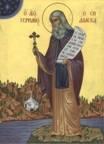 There he lived for 40 years. He built an orphanage and a school for the children who had lost their parents. Little children especially loved Herman. He taught them to love Jesus. When the children saw a great wave coming in from the sea, a tidal wave, they ran to “Apa” Herman, “Grandfather” Herman. Herman took his icon of the Theotokos to the beach and placed it in the sand. He told the children that the huge wave would stop there – and it did!
There he lived for 40 years. He built an orphanage and a school for the children who had lost their parents. Little children especially loved Herman. He taught them to love Jesus. When the children saw a great wave coming in from the sea, a tidal wave, they ran to “Apa” Herman, “Grandfather” Herman. Herman took his icon of the Theotokos to the beach and placed it in the sand. He told the children that the huge wave would stop there – and it did!
Fr. Herman planted the first seeds of the Orthodox faith in North America. He died at the age of 81 in 1837. Herman was one of the first saints of the Alaskan church.
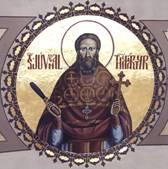 St. Juvenal, the Protomartyr
St. Juvenal, the Protomartyr
St. Juvenal was born in 1761 in Siberia. He was born John Hovorukhin, and took the name Juvenal when he was tonsured a monk in 1791. He was sent to Alaska from St. Petersburg as a missionary. St. Herman would tell the story of monks Juvenal and his friend Macarius traveling all over the area around Kodiak in little hide boats, teaching about Christ and baptizing. In 1795, Fr. Juvenal baptized more than 700 Chugatchi, and then crossed the Kenai Bay and baptized there. Then, in 1796, he reached the village of Quinahgak, where he was martyred by the natives there. He was struck from behind, yet prayed for those he had baptized. After his death, he got up and came after the killers, urging them to repent. Finally, he was hacked to pieces, the first martyr in North America. His brass pectoral cross was taken by a local shaman, who found there a power greater than his own, and wore it proudly.
St. Peter the Aleut:
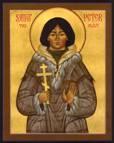 One of the Eskimo boys who heard about Jesus from Herman was named Chunuknuk. When he was baptized, he was given a new name, Peter. Peter learned about God and loved Him with all his heart and soul and mind. Peter also learned from his father and grandfather how to hunt and fish from his little kayak. He even hunted whales!
One of the Eskimo boys who heard about Jesus from Herman was named Chunuknuk. When he was baptized, he was given a new name, Peter. Peter learned about God and loved Him with all his heart and soul and mind. Peter also learned from his father and grandfather how to hunt and fish from his little kayak. He even hunted whales!
Peter went with the Russian fur traders to far-off California, hunting sea otters, with a group of fourteen Aleuts. There, he was captured by Roman Catholics who tried to make him change his faith. Remember the Uniats? They even cut off his fingers. But Peter would not deny his Church and faith. Finally, they killed Peter. His final words? “I am a Christian.” The next day, an order was received from the Spanish government in Monterey, to free the prisoners and bring them to Monterey, but Peter was already martyred.
St. Innocent, Equal to the Apostles:
About 200 years ago there was born in Russia a man named John Veniaminov. John, like many young men, got married and decided to become a priest. He had a baby boy. Life was fairly normal – but not for long.
One day Bishop Michael of Irkutsk asked for a priest to volunteer to go to far-away Alaska in the wilderness. There was a need for priests and teachers among the Eskimos and Aleuts. John volunteered; the bishop was so happy he called John the “son of obedience”. Soon John with his wife and little baby boy were on their way. Their ship landed in Unalaska, a damp, cold, windy, treeless place where lived Eskimos called Aleuts. John made friends with the Aleuts, learning their language. He even translated parts of the New Testament and the Liturgy into Aleut. He also rebuilt their church, hammering and sawing himself till it was done. The Aleuts were so happy; they loved their new priest. John and his wife also cared for the poor and sick and built a school and orphanage for children.
John wanted to tell all the Aleuts about Jesus. So, he traveled to all the surrounding islands by kayak. The water was col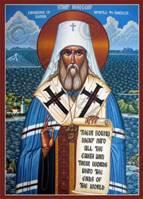 d and full of icebergs. But John spent days traveling by kayak and dogsled, telling people about the Lord and building churches. His legs became bent into the shape of a kayak, but still he traveled. Then, John and his family were sent to another tribe called the Kolosh in Sitka, Alaska. There he learned another language and was able to tell his new friends about Jesus. Slowly the Kolosh also became Christian.
d and full of icebergs. But John spent days traveling by kayak and dogsled, telling people about the Lord and building churches. His legs became bent into the shape of a kayak, but still he traveled. Then, John and his family were sent to another tribe called the Kolosh in Sitka, Alaska. There he learned another language and was able to tell his new friends about Jesus. Slowly the Kolosh also became Christian.
Later, John was called to Russia. He was ordained a bishop after the death of his wife and took the new name Innocent. He went back to Alaska as bishop. His territory included all his old friends, the Aleuts and the Kolosh. Bishop Innocent traveled by dogsled and kayak all over his diocese. He would spend the night cooking on a fire and roll up in his blanket with his Eskimo friends to sleep. Bishop Innocent was a true missionary and is remembered as the evangelizer of the Aleuts and the apostle to America.
St. Jacob Netsetov:
Saint Jacob was born on the Aleutian Islands. His father worked for the Russian Trading company and his mother was a native Alaskan. They raised their four children in the Orthodox faith. They spoke both Unangen and Russian. When they got older, the boys went to Russia to finish their education. St John chose seminary, married, and returned to the Aleutian Islands as a missionary priest. He cared for the communities along the entire chain of islands.
St. Alexis Toth:
Earlier we discussed the Uniates, Orthodox Christians moved wholesale by conquering armies into “Byzantine Rite” Roman Catholic parishes. As these Christians moved to the US, they needed priests. Fr. Alexis Toth was sent to minister to these immigrants, but received a cold welcome from the Roman Catholic bishop in the US. He was not even allowed to hold services. At the request of his parishioners, he traveled to San Francisco and met with the Russian Orthodox bishop. He was welcomed and on March 25, 1891, Bishop Vladimir traveled to Minneapolis to receive Fr. Alexis and 361 parishioners into the Orthodox faith. Fr. Toth continued to preach and to encourage the Slavic parishes and forming new parishes, working tirelessly even as his health began to fail. By the time of his repose in 1909, thousands of Carpatho-Russian and Galician Uniates had returned to Orthodoxy.
Metropolia to OCA:
As the settlement of the western parts of the US continued in the 1800s and Alaska was sold to the US by the Russians in 1867, the Russian Church needed a permanent presence on the mainland. They established the diocese of San Francisco, where there were many Russian settlers, in 1870. Slowly the bishops worked to represent Orthodoxy to the predominantly Protestant nation and to translate the Liturgy and music into English. Soon a church was established in New York. From 1898 to 1906, the head of the Russian Orthodox Church in America was Bishop Tikhon. He was a far-sighted man and founded a monastery to provide spiritual leadership and training; that monastery is St. Tikhon’s in Pennsylvania. He moved his diocesan see to New York. He founded the first seminary in Minneapolis. And, he tried to minister to all the Orthodox in America, not just Russians. Bishop Tikhon, a soft-spoken, good-natured man, was beloved in America. But, in 1907, he was recalled to Russia as Metropolitan of Moscow. Review his subsequent life in the last lesson.
Many Carpatho-Russians immigrated to the US at this time. Most were Uniats; review this in the last lesson. First under Fr. Alexis Toth, Bishop Vladimir received his entire parish of 361 parishioners into the Orthodox church in 1891. Then with torrential speed over the next 50 years, over 200 Uniat parishes reunited with the Russian Orthodox Church. They were even given their own bishop in 1938.
The Russian Revolution in 1917 had repercussions in America. In the past, because of its early missionary efforts in Alaska, the Russian Orthodox Church was the only Orthodox Church in America. But, after the Communist take-over, with the hierarchy in prison, the Russian church could no longer administer effectively abroad. Greeks, Syrians, Serbians, and other immigrants began to look to their home countries for leadership. Within the Russian community, some remained loyal to the Patriarch of Moscow, some to the new Synod created in Europe by the exiles who escaped the Communists (See last lesson. -- Russian Orthodox Church Outside Russia or ROCOR), and some wanted self-government for the North American Churches. Ties with Russia were severed in the 1920s and the “Metropolia” declared herself autocephalous, or self-governing. In 1970, the Metropolia petitioned and received autocephaly from the Patriarch of Moscow and renamed itself the Orthodox Church in America. The majority of Russian Churches joined the Metropolia, but some remained with Moscow and are known as the Patriarchal Church with a Bishop in New York. The OCA now has two seminaries, St. Tikhon’s and St. Vladimir’s. But, to further complicate matters, neither the Patriarch of Constantinople nor the Greek Orthodox Church recognized the right of the Patriarch to grant autocephaly.
Most recently, on May 17, 2007, the Act of Canonical Communion between the Patriarchal Church and the Russian Orthodox Church Outside of Russia (ROCOR) was signed. This reunited the Russian Orthodox Church, with President of Russia Vladimir Putin attending, hierarchs of both churches, and thousands of the faithful.
Play a Learning Game: Hangman – Take several important names from today’s lesson. Draw a gallows and little lines for each letter in the name. Students take turns guessing letters; if the letter is in the name, it is written on the correct space(s); if not, a body part is added to the gallows. Will the students identify the name before the man is hanged? Some names:
Herman Peter
Innocent Tikhon
Slavic traditions:
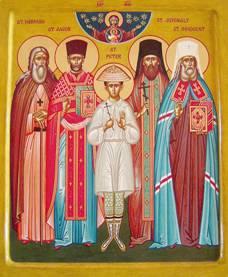 This part of the lesson should be fun. Have the class share foods they have eaten, types of music they have heard, etc. Bring in a speaker of Slavic descent or a CD with music. Bring some Slavic food. Learn a dance or two. Remember that the tradition of Pascha baskets is a Slavic one.
This part of the lesson should be fun. Have the class share foods they have eaten, types of music they have heard, etc. Bring in a speaker of Slavic descent or a CD with music. Bring some Slavic food. Learn a dance or two. Remember that the tradition of Pascha baskets is a Slavic one.
Primstav: Add St. Herman of Alaska on December 13, St. Juvenal on September 24, St. Peter the Aleut on December 12, and St. Innocent on March 31. How should each be symbolized?
Close with Prayer.